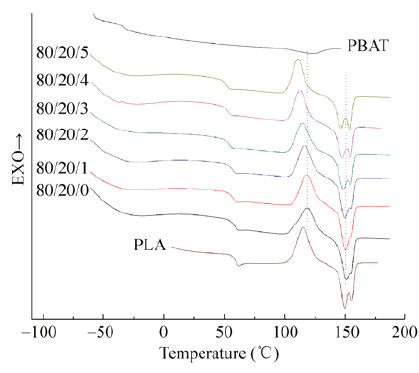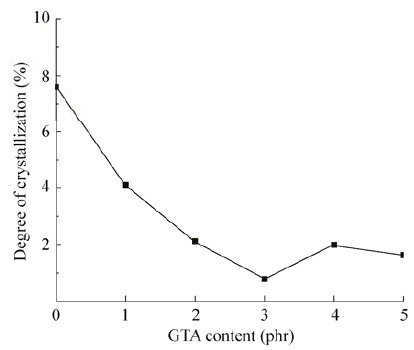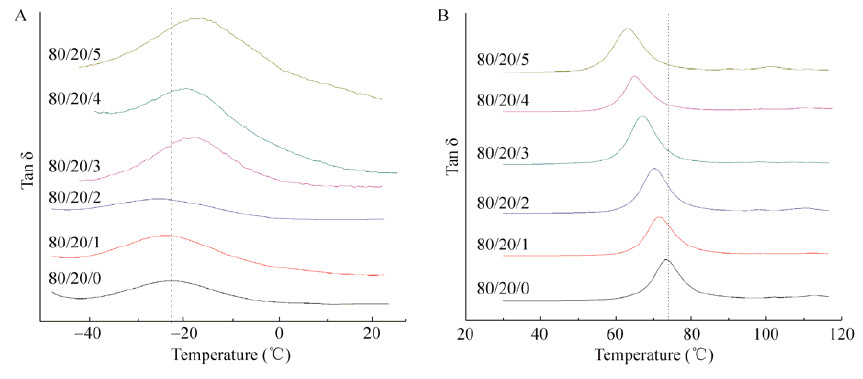
 , 靳玉娟, 张敏
, 靳玉娟, 张敏北京工商大学 材料与机械工程学院,北京 100048
基金项目:国家自然科学基金(No.51473006)资助
摘要: 利用转矩流变仪将聚乳酸 (PLA)、聚己二酸对苯二甲酸丁二酯 (PBAT) 和三乙酸甘油酯 (GTA) 熔融共混,利用差示扫描量热仪 (DSC)、动态热机械分析仪 (DMA)、万能材料试验机、冲击试验机、扫描电子显微镜 (SEM) 对共混物的热力学性能、力学性能以及微观形态结构进行测试和表征。实验发现,加入GTA后共混物的两相玻璃化转变温度呈相互靠近趋势,冷结晶温度和熔融温度都降低。当GTA加入量为3份时,共混物中分散相粒径减小,PLA/PBAT/GTA (80/20/3) 组分的断裂伸长率得到明显提升,增加了2.6倍,由未加入GTA时的17.7%增长到64.1%。
关键词: 聚乳酸 聚对苯二甲酸-己二酸丁二酯 三乙酸甘油酯 相容性 共混
Effect of glyceryl triacetate on properties of PLA/PBAT blends
Yang Nan, Wang Xiyuan, Weng Yunxuan

 , Jin Yujuan, Zhang Min
, Jin Yujuan, Zhang Min School of Materials and Mechanical Engineering of Beijing Technology & Business University, Beijing 100048, China
Received: March 30, 2016; Accepted: May 3, 2016
Supported by:National Natural Science Foundation of China (No. 51473006)
Corresponding authors:Yunxuan Weng. Tel: +86-10-68985380; E-mail: wyxuan@th.btbu.edu.cn
Abstract: Poly lactic acid (PLA)/Poly (butyleneadipate-co-terephthalate)(PBAT) and glyceryl triacetate (GTA) blend were prepared by torque rheometer,and the effect of GTA on thermodynamical performance,mechanical properties and microstructure of PLA/PBAT composites were studied using differential scanning calorimeter(DSC),dynamic mechanical analysis(DMA),universal testing machine,impact testing machine and scanning electron microscope(SEM). After adding GTA,Tg values of the two phases gradually became closer,blends cold crystallization temperature and melting temperature decreased. When with 3 phr GTA,the dispersed phase particle size of PLA/PBAT blend decreased. Mechanics performance test showed that the elongation at break and impact strength of the PLA/PBAT blend was greatly increased with 3 phr GTA,and the elongation at break increased 2.6 times,improved from 17.7% to 64.1%.
Key words: poly(lactic acid) poly(butyleneadipate-co-terephthalate) glyceryl triacetate compatibility blend
近年来,随着人们对废弃塑料制品由于不当处置带来环境污染问题的逐渐重视,生物降解高分子材料成为了关注的热点,聚乳酸 (PLA) 和聚对苯二甲酸-己二酸丁二酯 (PBAT) 是目前其中产业化生产规模和应用最广的两种材料。
聚乳酸 (PLA),目前主要是以玉米淀粉为主要原料,经发酵制得乳酸,乳酸再经化学聚合得到的一种生物基聚合物,具有完全生物降解性、可热塑加工等优点[1]。但是,PLA韧性差、质脆等缺点限制了其在薄膜等领域的应用,为此对PLA增韧成为了其改性中的一个重要研究内容[2-4]。聚对苯二甲酸-己二酸丁二酯 (PBAT),是以对苯二甲酸、己二酸、丁二醇为主要原料共聚得到的一种热塑性聚酯,具有较好的热塑加工性能,既有优良的延展性和韧性,也有较好的耐热性,同时兼具生物可降解性。
PLA、PBAT在性能上表现出一定互补性,共混PBAT可以增韧PLA[5-9]。但单纯将PLA和PBAT两者共混,两者相容性较差,常需用加入增容剂改善PLA/PBAT共混物的界面相容性。王垒等[10]使用含环氧基的反应型相容剂IGETABOND增容PLA/PBAT,共混体系的冲击强度和断裂伸长率都得到明显提升。Kumar等[11]添加GMA到PLA/PBAT共混体系中,发现GMA起到了反应性增容剂的作用,增大了共混物的冲击强度。Wang等[12]发现钛酸四丁酯能增强PLA与PBAT间的酯交换反应,促进两相间界面结合力。
三乙酸甘油酯 (GTA) 分子式C9H14O6,常被用于聚酯的改性助剂。本实验将PLA和PBAT按照80/20 wt%比例混合,加入不同份数GTA,研究其不同组分对PLA/PBAT (80/20) 共混物性能的影响。
1 材料与方法1.1 实验原料 PLA,REVODE110,密度为1.2 g/cm3,重均分子量3.5×105 g/mol,熔点160 ℃,分子量分布系数2.5,浙江海正生物材料有限公司;
PBAT,Biocosafe2003,密度为1.25 g/cm3,重均分子量1.0×104 g/mol,熔点115 ℃,重均分子量1.0×104 g/mol,分子量分布系数2.3,浙江杭州鑫富药业股份有限公司;
GTA,分子式C9H14O6,密度1.16 g/cm3,国药集团化学试剂有限公司。
1.2 主要设备及仪器 密炼机 (转矩流变仪),XSS-300,上海科创橡塑机械设备有限公司;差示扫描量热仪(DSC),Q100,美国TA公司;动态力学热分析仪 (DMA),242C,德国NETZSCH公司;微机控制电子万能试验机,CMT6104,中国美特斯工业系统有限公司;组合式数显冲击试验机,XJZ-50,承德市金建检测仪器有限公司。扫描电子显微镜 (SEM),FP2032/14,QUANTA FEG250,美国FEI公司。
1.3 试样制备 将PLA和PBAT置于80 ℃真空烘箱中真空干燥12 h。按PLA:PBAT=80:20的质量比称取原料,分别向PLA/PBAT共混体系中加入0份、1份、2份、3份、4份、5份的GTA,置于密炼机中进行熔融共混。混合温度设为 180 ℃,转速为60 r/min,共混时间为8 min。之后利用压机将混合后的物料于180 ℃的条件下压成4 mm厚度的片材。将片材用模刀冲裁得到拉伸强度、断裂伸长率和冲击强度测试样条。
1.4 测试与表征1.4.1 DSC 取不同GTA含量的样品组分,N2气氛下,将样品直接快速升温至190 ℃,并保持该温度3 min消除热历史后,再以30 ℃/min的速率降温至-70 ℃,随后以10 ℃/min的速率升温至190 ℃。
1.4.2 DMA 取不同GTA含量的样品组分,在液氮氛围下,从-45 ℃以3 ℃/min的升温速率升至120 ℃,频率1 Hz,振幅25 μm,最大力3 N。
1.4.3 拉伸强度和断裂伸长率 将测试样条在烘箱中干燥8 h后,实验室室温环境中放置48 h,依据GB/T 1040.2-2006进行测试。标距50 mm,拉伸速率50 mm/min,1A型试样。每组测定5次,结果取平均值。
1.4.4 冲击强度 依据GB/T 1043. 1-2008进行简支梁冲击强度测试,缺口样条,缺口深度2 mm,摆锤能量2.75 J,每组测定5次,结果取平均值。
1.4.5 SEM分析 将样条冲击断面进行喷金处理后,用SEM在加速电压为10 kV的条件下放大到5 000倍,观察表面形貌。
2 结果与讨论2.1 DSC结果分析 不同组分GTA的PLA/PBAT共混物的DSC二次升温曲线见图 1。
 |
| 图1 不同组分GTA的PLA/PBAT共混物的DSC二次升温曲线 Figure1 DSC curves of PLA/PBAT blends with different GTA contents. |
| 图选项 |
对图 1中数据进行处理,得到共混物的冷结晶温度 (Tcc) 和熔融温度 (Tm) 以及熔融焓 (ΔHm)、冷结晶焓 (ΔHcc)。通过ΔHm和ΔHcc可计算得出PLA在PLA/PBAT中的结晶度Xc,公式如下:
 | (1) |
表1 不同组分PLA/PBAT/GTA共混物的DSC数据Table1 DSC data of PLA/PBAT blends with different GTA contents
| PLA/PBAT/GTA sample | Tcc (℃) | Tm1 (℃) | Tm2 (℃) | △ Hm (J/g) | △ Hcc (J/g) | Xc (%) |
| PLA | 116.5 | 150.2 | 155.7 | 28.12 | 24.64 | 3.7 |
| PBAT | - | 118.9 | - | - | - | - |
| 80/20/0 | 119.1 | 150.0 | 155.6 | 24.80 | 19.10 | 7.6 |
| 80/20/1 | 118.5 | 150.0 | 155.3 | 22.10 | 19.00 | 4.1 |
| 80/20/2 | 116.8 | 149.6 | 155.1 | 21.50 | 19.90 | 2.1 |
| 80/20/3 | 114.9 | 148.6 | 154.4 | 20.90 | 20.30 | 0.8 |
| 80/20/4 | 112.2 | 147.5 | 154.2 | 19.70 | 18.20 | 2.0 |
| 80/20/5 | 111.2 | 145.8 | 154.1 | 20.40 | 19.10 | 1.6 |
表选项
从图 1、表 1可以看出,加入GTA后,PLA/PBAT共混物的冷结晶峰变窄,表明GTA的加入使得冷结晶过程缩短。同时共混物的冷结晶温度Tcc随着GTA添加量的增加而逐渐降低。未添加GTA时Tcc为119.1 ℃,PLA/PBAT/ GTA (80/20/5) 的Tcc降为111.2 ℃。共混物的冷结晶峰向低温方向移动,这也说明GTA的加入促进了聚酯分子链段的短程运动,使得聚合物链段在低温就具有足够的运动能力进行规则排列从而结晶,而且GTA含量越高,链段短程运动能力越强,冷结晶温度越低,冷结晶进程较快。
此外,由图 1还可以看到,不同组分的共混物都出现了熔融双峰,原因可能是在从冷结晶温度升至熔融温度的过程中,不稳定的晶型熔融后又重新结晶所造成的[12];随着GTA含量的增加,共混物的2个熔融峰也向低温方向移动,PLA/PBAT/GTA (80/20/0) 的Tm1为150.0 ℃,Tm2为155.6 ℃;PLA/PBAT/GTA (80/20/5) 的Tm1为145.8 ℃,Tm2为154.1 ℃。且随着GTA含量上升,熔融双峰中的第一个峰面积减小,第二个在增大,这可能是由于生成了更多的稳定晶型所造成的。
由公式 (1) 计算得到PLA在不同共混组分内的结晶度,如图 2所示。
 |
| 图2 不同组分GTA的PLA/PBAT共混物的结晶度 Figure2 The degree of crystallinity of PLA/PBAT blend with different GTA contents. |
| 图选项 |
未添加GTA的PLA/PBAT共混物中PLA结晶度Xc为7.6%。随着GTA添加量增加,共混物中PLA的Xc逐渐减小趋势,在GTA添加量3份时达到最小值0.8%。原因可能是,由于GTA的加入,增加了PLA和PBAT两相间的相容性,使得PLA与PBAT在结晶时相互影响。
2.2 DMA结果分析 图 3所示为不同GTA添加量的PLA/PBAT共混物的Tanδ-温度曲线,图 3A为低温区段(-60 ℃至20 ℃),图 3B为高温区段 (20 ℃至120 ℃)。
 |
| 图3 不同组分GTA的PLA/PBAT共混物的Tanδ-温度曲线 Figure3 Tanδ-temperature curves of PLA/PBAT blends containing GTA. (A) Low temperature stage (-60 ℃-20 ℃). (B) High temperature stage (20 ℃-120 ℃). |
| 图选项 |
损耗因子 (Tanδ) 峰的升高则表示了在该温度条件下相应分子运动单元的活动性增加,可以表征材料的玻璃化温度的相对大小。由图 3A可以看出,低温条件时,PBAT相的分子链链段开始运动,Tanδ峰升高,出现一个Tg,记作Tg1;由图 3B可以看出,温度升高后,PLA相的分子链链段开始运动,Tanδ峰又一次升高,在高温区段出现另一个Tg,记作Tg2。结合低温区段和高温区段,随着GTA添加量增加,共混物中PBAT相的Tg1和PLA的Tg2相互靠拢,表明PLA与PBAT部分相容。
对图 3中数据进行处理,得到Tg1和Tg2,两值间差值记作ΔTg,具体数据见表 2。
表2 不同组分GTA的PLA/PBAT共混物的DMA数据Table2 DMA data of PLA/PBAT blends with different GTA contents
| PLA/PBAT/GTA sample | Tg1 (℃) | Tg2 (℃) | Δ Tg (℃) |
| 80/20/0 | -21.0 | 73.4 | 94.4 |
| 80/20/1 | -21.1 | 71.5 | 92.6 |
| 80/20/2 | -20.4 | 70.8 | 91.2 |
| 80/20/3 | -16.7 | 65.3 | 82.0 |
| 80/20/4 | -16.5 | 64.8 | 81.3 |
| 80/20/5 | -16.2 | 63.5 | 79.7 |
表选项
从表 2可以看出,随着GTA含量的增加,PBAT相的玻璃化转变温度 (Tg1) 与PLA相的玻璃化转变温度 (Tg2) 有明显靠近趋势,ΔTg逐渐减小。纯PLA/PBAT组分的ΔTg为94.4 ℃,GTA加入后,ΔTg减小,PLA/PBAT/ GTA (80/20/5) 组分的ΔTg降低最为明显,降低到79.7 ℃。原因可能是由于GTA在两相界面间起到了类似嵌段共聚物的相容作用。
由表 2还可看出,共混物中PLA的Tg2相对PBAT的Tg1的变化更为明显,这可能是由于GTA的对PLA起到了增塑剂作用,增塑效果与PLA的冷结晶动力学之间存在着某种竞争机制,PLA增塑程度越大,分子链活动性增加就越大,PLA分子链的短程运动能力增加了,使得PLA相的Tg得到降低。
2.3 拉伸强度和断裂伸长率 不同比例下共混物的拉伸强度和断裂伸长率数据见表 3。
表3 不同GTA比例下PLA/PBAT共混物的拉伸性能Table3 Tensile testing data of PLA/PBAT/GTA blends
| PLA/PBAT/GTA sample | Elongation at break (%) | Tensile strength (MPa) |
| 80/20/0 | 17.7 | 43.5 |
| 80/20/1 | 19.4 | 40.8 |
| 80/20/2 | 34.1 | 38.9 |
| 80/20/3 | 64.1 | 37.1 |
| 80/20/4 | 55.3 | 35.7 |
| 80/20/5 | 20.5 | 34.2 |
表选项
由表 3可以看出,随着GTA含量的增加,共混物的拉伸强度逐渐降低,从43.5 MPa逐渐降低到34.2 MPa;但断裂伸长率明显增加,与PLA/ PBAT/GTA (80/20/0) 的17.7%相比,PLA/PBAT/ GTA (80/20/3) 达到了64.1%,提升了2.6倍,说明GTA的加入,使得PLA与PBAT的相容性得到改善,其中PLA充当了硬段,PBAT充当了软段。
2.4 冲击强度 不同组分GTA的PLA/PBAT共混物冲击强度数据见表 4,冲击强度柱状图见图 6。
表4 不同组分GTA的PLA/PBAT共混物冲击强度Table4 Impact testing data of PLA/PBAT/GTA blends
| PLA/PBAT/GTA sample | Impact strength (kJ·m2) |
| 80/20/0 | 6.0 |
| 80/20/1 | 5.6 |
| 80/20/2 | 4.3 |
| 80/20/3 | 6.9 |
| 80/20/4 | 5.7 |
| 80/20/5 | 6.6 |
表选项
 |
| 图4 冲击样条断面SEM照片 Figure4 SEM of the impact fracture surface of blends. (A) PLA/PBAT (80/20). (B) PLA/PBAT/GTA (80/20/3). |
| 图选项 |
由表 4可知,未添加GTA的PLA/PBAT (80/20) 组分冲击强度为6.0 kJ/m2,随着GTA添加量的增加,冲击强度先降低后提升,GTA含量低于3份时,冲击强度均低于纯PLA/PBAT共混组分;GTA含量3份时,PLA/PBAT/GTA (80/20/3) 的冲击强度提升至6.9 kJ/m2;随后的4份添加量的共混物冲击强度下降为5.7 kJ/m2,5份添加量的组分冲击强度为6.6 kJ/ m2。以上结果说明,加入GTA一定量后,PLA与PBAT两相间粘合力增强,界面层加厚,应力传导效应加强,GTA的加入对PLA/PBAT共混体系的韧性起到了正面作用,提高了其抗冲击性。
2.5 SEM分析 图 4A和B所示分别为PLA/PBAT (80/20) 和PLA/PBAT/GTA (80/20/3) 两组分冲击断面的SEM照片。
由图 4A可以看出,未加GTA的PLA/PBAT共混物中,PBAT作为分散相分散于PLA基体中,呈现“海岛结构”,孔洞结构明显,分散相PBAT颗粒粒径较大且分散不均匀,界面清晰,表明PLA与PBAT两相界面黏接力较差。图 4B可以看出,较之纯PLA/PBAT (80/20) 共混物,加入3份GTA后,共混物的冲击断面形貌中,PBAT颗粒粒径变小,分布更均匀,两相界面变得更加模糊;并且PLA/PBAT/GTA (80/20/3) 样条的断面形貌中出现了丝状结构,断面粗糙,表现出一定韧性断裂的特性。
3 结论 通过转矩流变仪熔融共混PLA/PBAT (80/20 wt%) 共混体系,研究添加不同含量的GTA后对共混物热力学、力学性能以及微观形态结构的影响。DSC二次升温曲线表明GTA的加入促进了共混物分子链段的运动,使得聚合物链段在低温就具有足够的运动能力进行规则排列从而结晶,共混物的冷结晶温度和熔融温度都发生降低。同时随着GTA含量增加,共混物中PLA和PBAT两相的玻璃化温度逐渐靠近,相容性得到改善,GTA含量5份时,ΔTg从94.4 ℃降低到79.7 ℃。随着GTA含量的增多,PLA/PBAT共混物的冲击强度和断裂伸长率都呈现先增长后降低的趋势。PLA/PBAT/GTA (80/20/3) 组分的力学性能提升明显,冲击强度最高,提高至6.9 kJ/m2,断裂伸长率与加入GTA前的17.7%相比,增至64.1%,提升了2.6倍。SEM照片显示,相比PLA/PBAT (80/20),PLA/PBAT/GTA (80/20/3) 中分散相PBAT颗粒尺寸减小,两相界面模糊,冲击断面形貌中出现丝状结构,表现出一定的韧性断裂特征,与力学性能测试结果相符。
参考文献
| [1] | Nampoothiri KM, Nair NR, John RP. An overview of the recent developments in polylactide (PLA) research.Bioresour Technol, 2010, 101(22): 8493–8501(in Chinese). |
| [2] | Garlotta D. A literature review of poly (lactic acid).J Polym Environ, 2001, 9(2): 63–84(in Chinese). |
| [3] | Weng YX. Review of study of synthesis, production, process and application of PLA.China Plast Ind, 2007, 35(S1): 69–73(in Chinese). 翁云宣. 聚乳酸合成、生产、加工及应用研究综述.塑料工业,2007,35(S1):69–73. |
| [4] | Zhang X, Li Y, Han LJ, et al. Improvement in toughness and crystallization of poly (L-lactic acid) by melt blending with ethylene/methyl acrylate/glycidyl methacrylate terpolymer.Polym Eng Sci, 2013, 53(12): 2498–2508(in Chinese). |
| [5] | Weng YX, Jin YJ, Meng QY, et al. Biodegradation behavior of poly (butylene adipate-co-terephthalate) (PBAT), poly (lactic acid) (PLA), and their blend under soil conditions.Polym Test, 2013, 32(5): 918–926(in Chinese). |
| [6] | Al-Itry R, Lamnawar K, Maazouz A. Rheological, morphological, and interfacial properties of compatibilized PLA/PBAT blends.Rheol Acta, 2014, 53(7): 501–517(in Chinese). |
| [7] | Fras T, Nishida M, Rusinek A, et al. Description of the yield state of bioplastics on examples of starch-based plastics and PLA/PBAT blends.Eng Trans, 2014, 62(4): 329–354(in Chinese). |
| [8] | Eslami H, Kamal MR. Effect of a chain extender on the rheological and mechanical properties of biodegradable poly (lactic acid)/poly[(butylene succinate)-co-adipate] blends.J Appl Polym Sci, 2013, 129(5): 2418–2428(in Chinese). |
| [9] | Quero E, Müller AJ, Signori F, et al. Isothermal cold-crystallization of PLA/PBAT blends with and without the addition of acetyl tributyl citrate.Macromol Chem Phys, 2012, 213(1): 36–48(in Chinese). |
| [10] | Wang L, Jin YJ, Meng QY, et al. Preparation and properties of poly (lactic acid)/poly (butylene adipate-co-terephthalate) composites with compatibilizer.Polym Mater Sci Eng, 2014, 30(1): 108–112(in Chinese). 王垒, 靳玉娟, 孟庆阳, 等. 聚乳酸与聚对苯二甲酸/己二酸/丁二酯共混物增容体系的制备及表征.高分子材料科学与工程,2014,30(1):108–112. |
| [11] | Kumar M, Mohanty S, Nayak SK, et al. Effect of glycidyl methacrylate (GMA) on the thermal, mechanical and morphological property of biodegradable PLA/PBAT blend and its nanocomposites.Bioresour Technol, 2010, 101(21): 8406–8415(in Chinese). |
| [12] | Wang BW, Zhao X, Wang LY. Isothermal crystallization and melting behaviors of biodegradable poly (lactic acid)/poly (butylene adipate-co-terephthalate) blends compatibilized by transesterification.Polym-Plast Technol Eng, 2013, 52(7): 718–726(in Chinese). |
| [13] | Yeh JT, Tsou CH, Huang CY, et al. Compatible and crystallization properties of poly (lactic acid)/poly (butylene adipate-co-terephthalate) blends.J Appl Polym Sci, 2010, 116(2): 680–687(in Chinese). |
| [14] | Signori F, Coltelli MB, Bronco S. Thermal degradation of poly (lactic acid) (PLA) and poly (butylene adipate-co-terephthalate) (PBAT) and their blends upon melt processing.Polym Degrad Stab, 2009, 94(1): 74–82(in Chinese). |
| [15] | Ko SW, Hong MK, Park BJ, et al. Morphological and rheological characterization of multi-walled carbon nanotube/PLA/PBAT blend nanocomposites.Polym Bull, 2009, 63(1): 125–134(in Chinese). |
| [16] | Sun ZQ, Zhang B, Bian XC, et al. Synergistic effect of PLA-PBAT-PLA tri-block copolymers with two molecular weights as compatibilizers on the mechanical and rheological properties of PLA/PBAT blends.RSC Adv, 2015, 5(90): 73842–73849(in Chinese). |
| [17] | Hiljanen-Vainio M, Varpomaa P, Sepp?l? J, et al. Modification of poly (L-lactides) by blending: mechanical and hydrolytic behavior.Macromol Chem Phys, 1996, 197(4): 1503–1523(in Chinese). |
| [18] | Nofar M, Maani A, Sojoudi H, et al. Interfacial and rheological properties of PLA/PBAT and PLA/PBSA blends and their morphological stability under shear flow.J Rheol, 2015, 59(2): 317–333(in Chinese). |
| [19] | Pivsa-Art W, Chaiyasat A, Pivsa-Art S, et al. Preparation of polymer blends between poly (lactic acid) and poly (butylene adipate-co-terephthalate) and biodegradable polymers as compatibilizers.Energy Procedia, 2013: 549–554(in Chinese). |
| [20] | Chinsirikul W, Rojsatean J, Hararak B, et al. Flexible and tough poly (lactic acid) films for packaging applications: property and processability improvement by effective reactive blending.Packag Technol Sci, 2015, 28(8): 741–759(in Chinese). |
| [21] | Al-Itry R, Lamnawar K, Maazouz A. Biopolymer blends based on poly (lactic acid): shear and elongation rheology/structure/blowing process relationships.Polymers, 2015, 7(5): 939–962(in Chinese). |
| [22] | Mohapatra AK, Mohanty S, Nayak SK. Study of thermo-mechanical and morphological behaviour of biodegradable PLA/PBAT/layered silicate blend nanocomposites.J Polym Environ, 2014, 22(3): 398–408(in Chinese). |
| [23] | Al-Itry R, Lamnawar K, Maazouz A. Reactive extrusion of PLA, PBAT with a multi-functional epoxide: physico-chemical and rheological properties.Eur Polym J, 2014: 90–102(in Chinese). |
| [24] | Reddy MM, Misra M, Mohanty AK. Biodegradable blends from corn gluten meal and poly (butylene adipate-co-terephthalate) (PBAT): studies on the influence of plasticization and destructurization on rheology, tensile properties and interfacial interactions.J Polym Environ, 2014, 22(2): 167–175(in Chinese). |
| [25] | Li K, Peng J, Turng LS, et al. Dynamic rheological behavior and morphology of polylactide/poly (butylenes adipate-co-terephthalate) blends with various composition ratios.Adv Polym Technol, 2011, 30(2): 150–157(in Chinese). |
